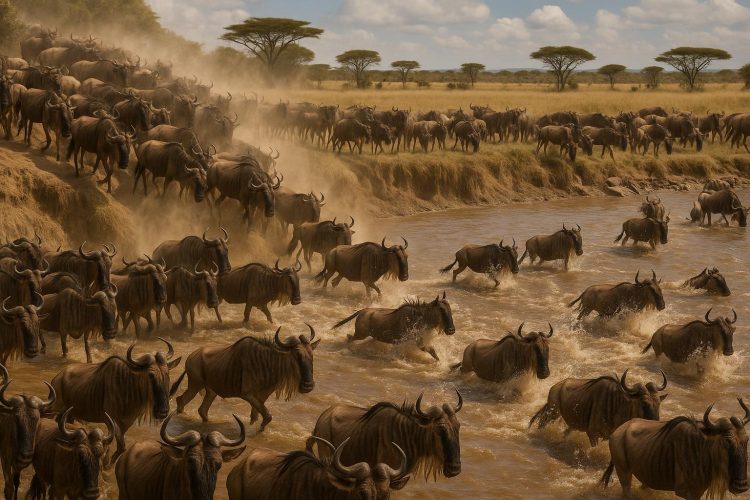The Significance of the Mara River Crossings
The Mara River crossings are among the most dramatic events during the annual migration of wildebeests. This natural phenomenon occurs primarily between the Serengeti in Tanzania and the Masai Mara in Kenya. It is part of the Great Migration, often referred to as one of the “Seven New Wonders of the World.”
The Life Cycle of the Migration
Each year, over 1.5 million wildebeests, accompanied by hundreds of thousands of zebras and gazelles, undertake a large circular route of approximately 1,800 miles. This migration is driven by the search for greener pastures and fresh water. The journey is perilous, with the Mara River crossings being one of the most challenging and dangerous obstacles.
Timelines and Patterns
The migration is highly influenced by rainfall patterns. Typically, the herds arrive at the Mara River from July to October. However, these timings can vary, depending on the onset of the rains. As the dry season intensifies in the Serengeti, the herds congregate near the Mara River.
In understanding the timelines, it is evident that the migration is not a random movement but a systematic response to environmental changes. The search for nourishment propels them forward, tracing a path molded by nature itself. Rainfall dictates the growth of the grasslands, ensuring that the herds have enough to sustain them on their long journey.
The Crossing Process
Crossing the river presents multiple threats. The river is deep and fast-flowing, with strong currents and steep banks. Yet, the biggest danger lies beneath the waters, where Nile crocodiles lie in wait. Moreover, the chaotic nature of the crossing often results in trampling incidents, leading to significant losses among the herds.
The river acts as a natural barrier and a challenging test of survival. Sometimes, the densely packed herds plunge into the water in sheer desperation, driven by the pressure from the mass behind them. Their instincts urge them forward, though survival lies not just in their resolve but in their ability to navigate the treacherous waters.
Observing these crossings reveals the sheer tenacity of life, with each animal driven by an innate instinct to reach the other side. For the predators lurking below, this is also a time of opportunity, a critical moment when the weak and slow are singled out by nature’s unseen hand.
Conservation and Tourism
The Mara River crossings attract thousands of tourists each year, making it a significant contributor to the local economy. However, this influx of visitors poses challenges to conservation efforts. It’s essential to balance tourism with the preservation of this natural spectacle. For more information on responsible tourism and conservation efforts, consider visiting resources like the African Wildlife Foundation or the Conservation International.
Tourism provides substantial financial support for conservation initiatives, helping to fund research and protect these natural habitats from external threats. However, the increased human activity and infrastructure development can disrupt the fragile ecosystems that support the migration. Sustainable tourism practices are crucial in ensuring that the natural environment remains undisturbed and capable of sustaining future migrations.
The balance between tourism and conservation requires coordinated efforts from wildlife authorities, conservation groups, and local communities. Ensuring that the migration remains intact and the ecosystems continue thriving necessitates careful planning and guided tourism practices. Those engaged in these efforts work persistently to enhance the visitor experience while minimizing human impact on the environment.
Understanding the dynamics of the Mara River crossings provides insight into the broader ecological and environmental implications of the Great Migration. Both nature enthusiasts and researchers continue to study this extraordinary journey, reflecting on its importance to biodiversity and ecosystem sustainability.
In a broader context, these crossings underscore the significance of interconnected ecosystems. The movement of wildebeests and accompanying herds not only replenishes the grasslands but also maintains a delicate balance among predator populations. The spectacle serves as a reminder of the intricate relationships that exist within the natural world, highlighting humanity’s role in preserving such phenomena.
Research and technological advancements have made studying the Great Migration continually fascinating. Satellite tagging, aerial surveys, and data analysis methods are advanced tools in drawing insights into migration patterns and behavior. As we learn more about these migrations, the information not only aids conservation efforts but also enriches our understanding of planetary life processes.
The role of education in this process cannot be underestimated. By increasing awareness through documentaries, publications, and interactive educational programs, the global audience can become engaged stakeholders in conservation initiatives. Ensuring that local communities are involved in these educational efforts enhances the prospects of sustainable practices taking root at the grassroots level.
The Mara River crossings, as part of the Great Migration, remain a living testament to the resilience and tenacity of nature. Recognizing the importance of this phenomenon not only for the animals that undertake the journey but also for the broader ecological systems encourages ongoing conservation efforts. Witnessing this unfolding drama year after year reminds us of the value of preserving natural spectacles for future generations.
Through ongoing research and responsible tourism, the legacy of the Great Migration can continue to captivate and educate those who seek to witness one of nature’s most awe-inspiring orchestrations. With continued efforts in conservation and global cooperation, the future of this remarkable event can remain secure, a timeless reminder of life’s unyielding endurance.
